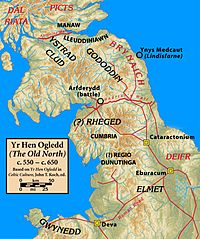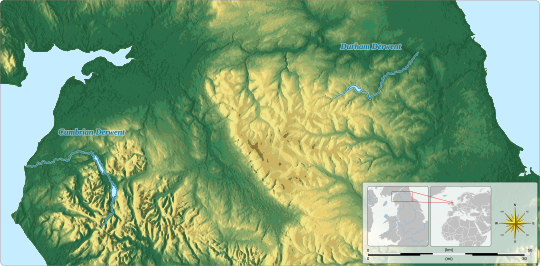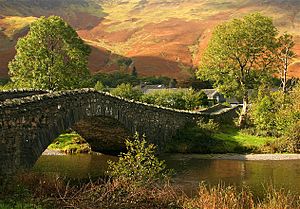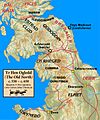Dinogad's Smock facts for kids
Dinogad's Smock (also called Dinogad's Cloak) is an Old Welsh lullaby. It tells the story of a baby named Dinogad. The baby is wrapped in a special smock (a type of long shirt or dress). This smock is made from the skins of a marten. The poem gets its name from this special garment.
The lullaby talks about Dinogad's father. It describes how brave and skilled he was at hunting. Sadly, the poem suggests the father is no longer alive.
This old poem comes from a book written in the 1200s. It's called the Book of Aneirin. This book was made in a monastery in Wales. The poem was added into a much older epic poem called Y Gododdin. This longer poem is said to be by a famous bard named Aneirin.
It's hard to know exactly when Dinogad's Smock was first written. Most experts believe it was composed around the late 600s. This was in an old kingdom called Kingdom of Strathclyde. This kingdom was in what is now southern Scotland.
The poem gives us clues about life in early medieval times. It shows us the culture of people who spoke Celtic languages. These people lived in what was then northern England and southern Scotland. The poem also helps us learn about the extinct Cumbric language. It even tells us about animals that lived in Britain back then. Some think it proves that the Eurasian Lynx lived in Britain much later than once thought.
Contents
The Poem
What the Poem is About
This poem is 17 lines long. It is spoken to baby Dinogad. He is in his cradle, wearing his marten-skin smock. The poem describes how his father used to go hunting. The smock was a long dress, common for babies back then.
First, the poem describes the smock. Then, it lists the animals Dinogad's father caught. It tells how bravely he hunted them. It also shows his great skill as a hunter. Dinogad's father must have been a powerful person. A marten-skin smock was very valuable. The poem also mentions that he had at least eight slaves.
The Original Text and Translation
Here is the original Old Welsh poem. Next to it is an English translation.
| Old Welsh text | English translation |
|---|---|
|
Peis dinogat e vreith vreith. o grwyn balaot ban wreith. chwit chwit chwidogeith. gochanwn gochenyn wythgeith. pan elei dy dat ty e helya; llath ar y ysgwyd llory eny law. ef gelwi gwn gogyhwc. giff gaff. dhaly dhaly dhwg dhwg. ef lledi bysc yng corwc. mal ban llad. llew llywywg. pan elei dy dat ty e vynyd. dydygai ef penn ywrch penn gwythwch pen hyd. penn grugyar vreith o venyd. penn pysc o rayadyr derwennyd. or sawl yt gyrhaedei dy dat ty ae gicwein o wythwch a llewyn a llwyuein. nyt anghei oll ny uei oradein. |
Dinogad's smock, speckled, speckled, I made from the skins of martens. Whistle, whistle, whistly we sing, the eight slaves sing. When your father used to go to hunt, with his shaft on his shoulder and his club in his hand, he would call his speedy dogs, "Giff, Gaff, catch, catch, fetch, fetch!", he would kill a fish in a coracle, as a lion kills an animal. When your father used to go to the mountain, he would bring back a roebuck, a wild pig, a stag, a speckled grouse from the mountain, a fish from the waterfall of Derwennydd Whatever your father would hit with his spear, whether wild pig or lynx or fox, nothing that was without wings would escape. |
Where the Poem is Set
Clues from place names and the Book of Aneirin show the poem was written between the 400s and 1000s. It was created in one of the kingdoms of the Hen Ogledd (the "Old North"). The poem mentions a river called Derwennyd. This name is the old form of the modern river name Derwent. There are several rivers named Derwent in northern England.

Some experts first thought the poem referred to the Durham Derwent. This was because the poem was found with Y Gododdin, which is about the Gododdin kingdom. However, Dinogad's Smock was added to Y Gododdin by mistake. So, there's no real reason to link it to the Gododdin area.
The poem also mentions a rayadyr (waterfall) on the Derwennyd. The Durham Derwent has no waterfalls. Because of this, and its closeness to mountains (vynyd), many now believe it refers to the Cumbrian Derwent. This river is near the Lake District. If this is true, the waterfall might be Lodore Falls. This would place the poem's setting in the old kingdom of Rheged.
The Poem's Language
Dinogad's Smock was written down in the 1200s. It was likely copied in Wales from an older book from the Kingdom of Strathclyde. So, it uses Middle Welsh spelling. But it also has clues about the Cumbric language. Cumbric was like Welsh and was spoken in southern Scotland and Cumbria until about the 1100s.
One interesting thing is the word gwreith in the second line. It means "I made." This suggests the lullaby might have been first written in an even older language called Common Brittonic. Also, the poem often uses penn ("head") to mean a single animal. For example, penn ywrch means "a roebuck." This is not common in Welsh today, but it is in Breton. This suggests it was used in a shared ancestor language of Welsh, Cumbric, and Breton.
Who was Dinogad?
The name Dinogad means "having a fort in battle." This name is also found in Welsh as Dinacat and later Dingad. A king of Strathclyde, Donnchad mac Crinain, had a similar name.
Some historians think the Dinogad in the poem might be Dunod the Stout. He was a king of a small area in northern England. But this idea is hard to prove.
The Book and its History
"Dinogad's Smock" is found in only one book, the 13th-century Book of Aneirin. This book was made in a Welsh monastery. The poem appears in a version of Y Gododdin. That epic poem tells about a battle in the 500s.
The Book of Aneirin was written by two different scribes (copyists). "Dinogad's Smock" is in the part written by Scribe A. It seems Scribe A updated the language of the old texts he copied.
Y Gododdin is linked to the bard Aneirin. But "Dinogad's Smock" was not originally part of it. It was a separate song passed down orally. It seems a scribe wrote the poem in a blank space on a manuscript. Later, another copyist thought it was part of Y Gododdin and added it in. The poem's old language suggests it was added to the same manuscript as Y Gododdin in the 600s. This happened in Strathclyde. That manuscript, or a copy, became one of the sources for the Book of Aneirin.
Some experts think the scribe added "Dinogad's Smock" because both poems shared a sad theme. They both spoke of loss. Others believe its inclusion shows the poem was valued as literature, not just a children's song.
Animals and History
"Dinogad's Smock" gives us clues about animals in early medieval northern Britain. It lists seven animals that were hunted: marten, roe deer, "stag," fish, fox, grouse, wild boar, and possibly lynx.
Archaeologists have found bones of most of these animals. They were found in places like Fishergate in York. These finds match the poem's description. They show what animals were hunted back then. The mention of marten furs for fancy clothes also fits with other evidence from that time.
The Mystery of the llewyn (Lynx)
The animal called llewyn in the poem has been much debated. Some scholars thought it meant red fox or wildcat. Others thought it might mean lynx.
Before the 1990s, people thought lynx had died out in Britain long before the 600s. But then, scientists used radiocarbon dating on old lynx bones. They found that lynx were definitely in Kinsey Cave in Craven in the 400s. They might have been there as late as 600 AD. Kinsey Cave is not far from the Cumbrian Derwent. This river is the most likely place for the poem's setting. So, it's possible lynx were still in the area in the 600s.
After these discoveries, some experts changed their minds. They said that while llewyn might still mean fox, it was possible it meant lynx. This is because if lynx died out, there might not be a word for them left in modern Celtic languages.
Some researchers now use "Dinogad's Smock" as evidence. They say it shows lynx survived in Cumbria after the Roman period. This idea supports bringing lynx back to wild areas of the United Kingdom. Famous environmentalist George Monbiot has also used the poem to argue for bringing back lynx and for rewilding Britain.
Modern Music
In 2001, a Welsh composer named Rhian Samuel set Dinogad's Smock to music. It was for piano and voices. This was part of her collection called Cerddi Hynafol ("Ancient Songs"). She updated some of the words and added an English translation. She called the song Hwiangerdd Dinogat ("Lullaby for Dinogat").
The music helps tell the story. It uses soft, rocking sounds for the baby. It uses strong, fast music for the father's hunting. It even has "subtle bird calls" in the piano part.
The Welsh folk music group Ffynnon also put the poem to music in 2006. Their version combines the poem with old Cumbrian sheep-counting rhymes. These rhymes are also thought to come from the Cumbric language.
Images for kids
-
The kingdoms of the Old North, where Y Gododdin and Dinogad's smock are set.






